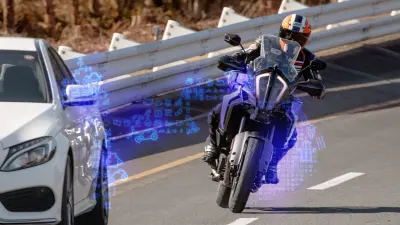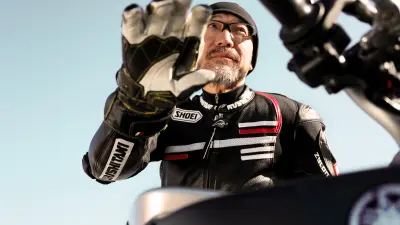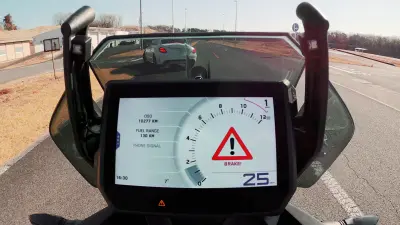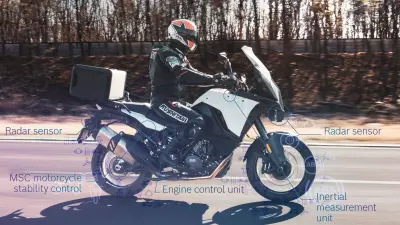Safer riding: assistance systems help take the strain out of motorcycling

Bosch’s radar-based assistance systems monitor a rider’s surroundings and automatically keep the bike at a safe distance from vehicles in front. We asked the motorcycling journalist Kentaro Sagawa to put these new systems to the test.
Safer, yes. But what about fun?

Advanced rider assistance systems (ARAS) mean that motorcyclists can now feel safer in the saddle. These electronic, radar-based aids warn about hazards such as a vehicle approaching in the rider’s blind spot or an imminent frontal collision. Among the systems included here is ACC adaptive cruise control, which can automatically adjust the bike’s speed to maintain a safe following distance. It’s clear that such systems offer huge benefits in everyday road traffic, but ardent motorcyclists might well ask whether this just spoils their fun. To find out, the motorcycle journalist Kentaro Sagawa test-rode a bike fitted with the latest assistance systems. He shares his impressions in the video below.

Loading the video requires your consent. If you agree by clicking on the Play icon, the video will load and data will be transmitted to Google as well as information will be accessed and stored by Google on your device. Google may be able to link these data or information with existing data.
“I would never have thought that such systems could be so helpful.”
Sensors monitor the bike’s surroundings
Alongside his job as a journalist, Kentaro Sagawa also runs a motorcycle training school in Tokyo. “Always keep a close eye on what other road users are doing” is one of his golden rules for motorcycle novices. But he’s also well aware of how difficult this is: “There’s always the danger of a vehicle appearing out of your blind spot.” Bosch engineers have now come up with a solution. The blind spot detection function provides motorcyclists with an extra eye.


This is how it works: two radar sensors — one at the front, one at the rear — scan the motorcycle’s surroundings. If the rear radar sensor detects a vehicle in the rider’s blind spot, a warning automatically appears — in the rear-view mirror, say. If the front radar sensor detects that the motorcycle is getting too close to the vehicle in front, a warning will also be displayed. If the rider still doesn’t react, the system can warn the rider by automatically activating a series of short brake jerks.
Where the core components of ARAS are installed
The forward collision warning function is permanently on. However, riders can use a switch on the handlebars to activate or deactivate the adaptive cruise control. Especially when there is a lot of traffic about, the safety systems take the strain off the rider, automatically regulating speed and maintaining a predefined distance to the vehicle in front. Adaptive cruise control is the result of various systems interacting in a flash: if the front radar detects that the motorcycle is getting too close to the vehicle ahead, it instructs the engine control unit and motorcycle stability control to decelerate.
MSC motorcycle stability control, one of the core components of ARAS, is itself an innovative two-wheeler technology. MSC supports riders both on straight stretches of road and in bends. Here, sensors monitor parameters such as lean angle and front- and rear-wheel speed, and the inertial measurement unit, a part of MSC, analyzes acceleration and angular velocity nearly 100 times per second. By analyzing these parameters, braking and acceleration force are electronically adjusted to the actual situation, thereby preventing the bike from skidding or the rear wheel from lifting up during braking.
How motorcycle ABS shed the pounds

This extremely complex process occurs in the blink of an eye. To a great extent, this effective combination of radar sensors and MSC is the result of Bosch’s vast experience and know-how. It was back in 1978 that Bosch developed the first ever production-ready ABS for automobiles. This was followed up in 1995 with an ABS unit for motorcycles. It weighed in at 4.5 kilograms — compared to just 450 grams for the latest unit.
As of the last two product generations, Bosch has shifted to tailoring ABS units to the requirements of motorcycles rather than simply adapting the technology used for cars. Here, too, the facts speak for themselves: according to a study by Bosch, around one-quarter of all motorized two-wheeler accidents resulting in injury could be avoided if all motorcycles were equipped with ABS. More and more countries are therefore making it mandatory.
“Motorcyclists carry a lot of responsibility — both for themselves and for others. Safety systems do not absolve them of this, but they do provide vital backup for human capabilities in critical situations.”
Vision zero: riding toward a safer future

Innovations such as the Bosch advanced rider assistance systems play a crucial role in what the company calls its “vision zero”: the goal of eradicating road fatalities. Manufacturers such as Ducati, KTM, and Kawasaki will soon be installing advanced rider assistance systems in their motorcycles. With the motorcycle market growing, the importance of such technology can only increase. According to a study by the automotive research company FOURIN, global production of two-wheelers will rise from its 2018 level by more than 13 percent by 2030.






